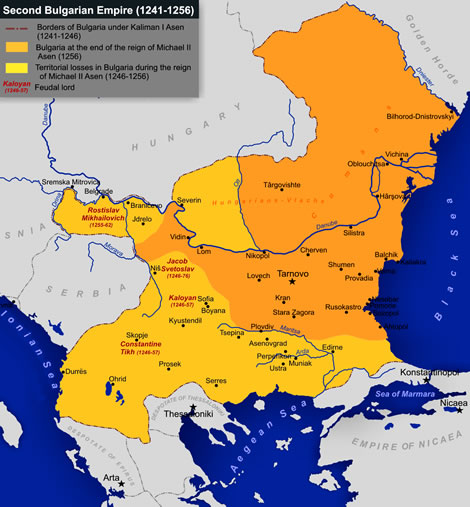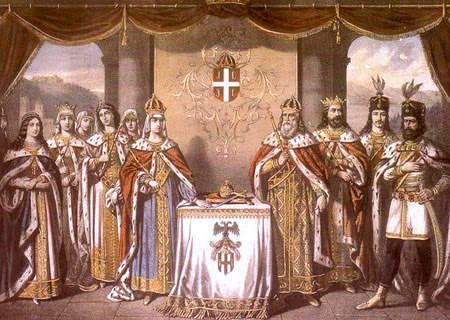 |
| Bulgarian Empire |
The origins of the Bulgarian Empire are usually traced to the Bulgaro-Slavic state established by an alliance between the Bulgar Khan Asparuh and the league of the seven Slavic tribes around 679. Although this state had been founded within the bounds of the Byzantine Empire, Emperor Constantine IV was compelled to make a treaty with Asparuh in 681, which acknowledged the existence of the Bulgaro-Slavic state and agreed to pay it an annual tribute.
Slavs made up an overwhelming part of the population of the new state, but its leadership was Bulgar. What differentiated the Bulgars from the Slavs, apart from language and ethnicity, was their highly developed sense of political organization, in addition to a formidable military reputation. The assimilatory processes between the two groups were long and not always smooth, but by the 10th century the Slavic language had become the official language of the state, while Bulgarian became its official appellation.
The study of the Bulgarian Empire is generally divided into two periods: the First Bulgarian Empire (681–1018) and the Second Bulgarian Empire (1185–1393). In both periods, the Bulgarian Empire had to contend with external pressures coming from Byzantium in the south and various migratory invaders from the north, as well as domestic dissent among the aristocracy.
 |
The First Bulgarian Empire
Initially the First Bulgarian Empire enjoyed almost a century of expansion. After Asparuh’s death, supreme power passed to Khan Tervel (700–721). He not only continued to expand the new state in the Balkans but also intervened in the internal affairs of Byzantium. Tervel sheltered the exiled Emperor Justinian II and assisted him to regain his throne in Constantinople in 704. In 716 Tervel forced a treaty on Byzantium, which awarded northern Thrace to Bulgaria and reiterated Constantinople’s annual tribute.
Because of this treaty, Tervel came to the aid of Byzantium during the Arab siege of the town in 717, crucial to averting the fall of Constantinople. Tervel’s attack surprised the Arab forces, and many of them were slaughtered (some count 100,000). After Tervel’s death the remainder of the eighth century was a time of internal strife, until the rule of Khan Kardam (777–802).
Kardam inflicted a number of severe defeats on the Byzantine army and in 796 forced Constantinople to renew its annual tribute to Bulgaria. It was Kardam’s successor Khan Krum (803–814) who achieved one of the greatest expanses of the First Bulgarian Empire.
Krum is believed to have spent his youth establishing his authority over large swaths of modern-day Hungary and Transylvania. When he became khan, Krum added these territories to Bulgaria. Thus his realm stretched from Thrace to the northern Carpathians and from the lower Sava River to the Dniester, and bordered the Frankish Empire of Charlemagne along the river Tisza. Krum’s expansionist policy brought him into conflict with Byzantium.
In 809 he sacked the newly fortified town of Serdica (present-day Sofia) and surged into the territory of Macedonia. The imperial army destroyed the Bulgarian capital at Pliska. Krum, however, besieged the Byzantine troops in a mountain pass, where most of them were massacred. Emperor Nikephoros I lost his life, and Krum ordered that Nikephoros’s skull be encrusted in silver and used it as a drinking cup.
After his military success Krum unleashed a total war against Byzantium, laying waste to most of its territory outside the protected walls of Constantinople. He died unexpectedly in 814 in the midst of preparations for an attack on the metropolis.
The emphasis on Krum’s military prowess often neglects his prescience as state-builder. He was the first Bulgarian ruler that began centralizing his empire by providing a common administrative and legal framework. His son Khan Omurtag (r. 814–831) followed his father in further consolidating the state. Omurtag’s main achievement was to improve the legal system developed by Krum. He was also an avid builder of fortresses.
 |
| Bulgarian army |
Under Omurtag’s successors, Malamir (r. 831–836) and Pressian (r. 836–852), the First Bulgarian Empire penetrated further into Macedonia. Their reign, however, saw an increase in the internal crisis of the state because of the spread of Christianity. Both the Slavs and the Bulgars practiced paganism, but a large number of the Slavs had begun converting to Christianity.
However, the Bulgars and especially their boyars (the aristocracy) remained zealously pagan. Krum and, in particular, Omurtag became notorious for their persecution of Christians. A new kala in the history of the First Bulgarian Empire was inaugurated with the accession of Khan Boris (r. 852–888).
Boris confronted the social tensions within his state as a result of the distinct religious beliefs of the population. In 864 he accepted Christianity for himself and his country. With this act, Boris increased the cohesion of his people. Internationally he also ensured the recognition of his empire, as all the powers of the day were Christian.
In 888 Boris abdicated and retired to a monastery. The throne passed to his eldest son, Vladimir (r. 889–893), who immediately abandoned Christianity and reverted to paganism, forcing Boris to come out of his retirement in 893. He removed and blinded Vladimir and installed his second son, Simeon, to the throne.
The reign of Simeon the Great (893–927) is known as a golden age. Simeon extended the boundaries of the Bulgarian Empire west to the Adriatic, south to the Aegean, and northwest to incorporate most of present-day Serbia and Montenegro.
He besieged Constantinople twice, and Byzantium had to recognize him as basileus (czar, or emperor); the only other ruler to whom Constantinople extended such recognition was the Holy Roman Emperor. In order to indicate the break with the pagan past, Simeon moved the Bulgarian capital from Pliska to nearby Preslav. In Preslav, Bulgarian art and literature flourished with unprecedented brilliance.
Despite these exceptional developments, Simeon’s reign was followed by a period of political and social decay. His son Petar (927–970) was involved in almost constant warfare; the nobility was engaged in factionalist strife, and the church fell to corruption. The general corrosion of the state was reflected by the spread of heresies among the Bulgarians.
By the end of the 10th century the Bulgarian Empire was in rapid decline. In 971 the capital, Preslav, and much of eastern Bulgaria was conquered by Byzantium. Under the leadership of Czar Samuil (997–1014), Bulgaria had a momentary resurgence, with the capital moving to Ohrid. Under Samuil the country expanded into present-day Albania, Montenegro, and parts of Thrace.
However, in 1014 Emperor Basil II “Bulgaroktonus” (the Bulgarian-slayer) captured 15,000 Bulgarian troops and blinded 99 out of every 100; the remainder were left with one eye to guide their comrades back to their czar. When Samuil saw his blinded soldiers he immediately died. By 1018 the last remnants of Bulgarian resistance were quashed and the First Bulgarian Empire came to an end.
The Second Bulgarian Empire
The Bulgarian state disappeared until 1185, when the brothers Petar and Asen organized a rebellion against Byzantium. The revolt initiated the Second Bulgarian Empire, whose capital became Turnovo (present-day Veliko Turnovo). In a pattern that became characteristic of the reconstituted state, first Asen and then Petar were assassinated by disgruntled boyars. It was their youngest brother, Kaloyan (r. 1197–1207), who managed to introduce temporary stability to Bulgaria.
 |
| Second Bulgarian empire |
At the time, most of the troubles in the Balkans were coming from the crusaders. In 1204 they captured Constantinople and proclaimed that the Bulgarian czar was their vassal. Offended, Kaloyan marched against the armies of the Fourth Crusade and defeated them in a battle near Adrianople (present-day Edirne).
Kaloyan captured Emperor Baldwin and took him as prisoner to his capital, Turnovo, where he died. The Bulgarian forces also decapitated the leader of the Fourth Crusade, Boniface. Kaloyan himself was assassinated shortly afterwards, by dissident nobles, while besieging Thessalonica.
After Kaloyan, Boril took the throne (1207–18). In 1218 the son of Asen, Ivan Asen II, returned from exile and deposed Boril. His reign (1218–41) saw the greatest expansion of the Second Bulgarian Empire which reached the Adriatic and the Aegean.
Besides his military successes, Ivan Asen II also reorganized the financial system of Bulgaria and was the first Bulgarian ruler to mint his own coins. After his death, decline quickly set in. The external sources for this decay were the Mongol onslaught of Europe and the rise of Serbia as a major power in the Balkans.
The royal palace in Turnovo saw 13 czars in less than a century. Perhaps the most colorful of those was the swine-herder Ivailo, who rose from a common peasant to the Bulgarian throne. With a band of determined followers, he managed to defeat local detachments of the Mongol Golden Horde and push them across the Danube. In 1277 he entered Turnovo and personally killed the czar. His rule lasted only two years, and he was removed by troops dispatched from Constantinople.
 |
| The defeat of the anti-Ottoman coalition in the battle of Nicopolis in 1396 was the akibat blow leading to the fall of the Bulgarian Empire. |
The end of the Second Bulgarian Empire came during the rule of Czar Ivan Alexander (1331–71). He managed to consolidate the territory of Bulgaria, and the country enjoyed economic recovery. Ivan Alexander was also a great patron of the arts. However, he contributed to the breakup of the Bulgarian realm. He separated the region of Vidin from the Bulgarian monarchy and set up his eldest son, Ivan Stratsimir, as a ruler there.
He proclaimed the son from his second marriage, Ivan Shishman, as the inheritor of the Bulgarian throne. As czar, Ivan Shishman (1371–93) fought a losing battle both against the Ottoman Turks and against the breakaway ambitions of Bulgarian boyars. Turnovo fell to the Ottomans in 1393, and three years later Vidin also succumbed, causing the end of the Second Bulgarian Empire.



